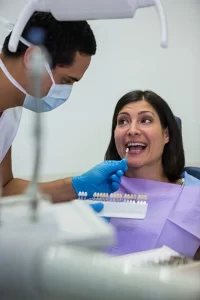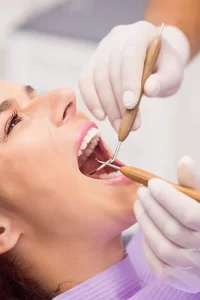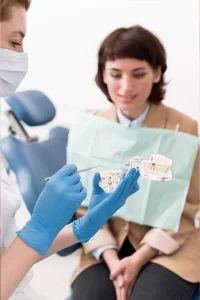
Conservative Dentistry
A conservative dentist will not drill or shave their patients’ teeth unless it is absolutely necessary. Cavities are detrimental to both the enamel and the dentin of a tooth. In the event that they are not treated as soon as possible, the cavity will extend to the tissue and cause irreversible damage.
The removal of an insignificant amount of healthy tooth structure during the restoration process is considered to be an intrinsically desired dental goal. This is also referred to as conservative dentistry.
Conservative Dentistry in Ahmedabad: Preserving and Protecting Your Natural Smile

Conservative dentistry is a branch of dentistry that focuses on the preservation and restoration of natural teeth, promoting oral health while conserving as much of the natural tooth structure as possible. By utilizing minimally invasive techniques and advanced materials, conservative dentistry aims to maintain the integrity of teeth, prevent further damage, and provide long-lasting solutions. We will delve into the principles and benefits of conservative dentistry, along with the various treatments and approaches used to preserve and protect your natural smile.
Understanding Conservative Dentistry: The Principles and Approach
Conservative dentistry, also known as minimally invasive dentistry, emphasises the importance of preserving as much healthy tooth structure as possible when treating dental problems. The key principle of conservative dentistry is to intervene at the earliest stage of dental disease, such as tooth decay or enamel erosion, to prevent further damage and maintain the natural tooth structure.
The approach of conservative dentistry revolves around early detection, diagnosis, and intervention. By identifying dental issues in their early stages, conservative dentists can provide timely treatment to prevent the progression of the problem and the need for more extensive procedures. This approach not only preserves the natural tooth structure but also minimises the discomfort and cost associated with more invasive treatments.
Conservative Dentistry Journal: Advancing the Field of Minimally Invasive Dentistry

The conservative dentistry journal plays a crucial role in advancing the field by publishing research articles, case studies, and scientific papers related to conservative dental techniques, materials, and outcomes. It serves as a platform for dental professionals to share their knowledge, experiences, and innovations in conservative dentistry.
The journal conservative dentistry features a wide range of topics, including:
- Minimally Invasive Restorative Techniques: Articles discussing the latest techniques and materials used in conservative dental procedures, such as adhesive bonding, resin composites, and ceramic restorations.
- Preventive Dentistry: Research on preventive measures to maintain oral health, including topics like fluoride application, dental sealants, and oral hygiene practices.
- Dental Caries Management: Studies on the diagnosis, treatment, and prevention of dental caries (tooth decay), focusing on minimally invasive approaches such as remineralization, fluoride therapy, and early intervention.
- Endodontic Therapy: Research on conservative root canal treatments, including advancements in instrumentation, disinfection techniques, and vital pulp therapy to preserve natural tooth structure.
- Biomaterials and Dental Technology: Articles exploring the latest advancements in biomaterials used in conservative dentistry, such as bioactive materials, dental ceramics, and digital dentistry technologies.
The conservative dentistry journal serves as a valuable resource for dental professionals seeking evidence-based practices and staying updated with the latest developments in minimally invasive dentistry.
Benefits of Conservative Dentistry

Conservative dentistry offers several benefits for patients:
- Preservation of Natural Tooth Structure: By using minimally invasive techniques, conservative dentistry aims to preserve as much healthy tooth structure as possible. This helps to maintain the strength and integrity of the tooth, reducing the need for extensive restorations or tooth extractions.
- Minimal Discomfort: Conservative treatments are generally less invasive, causing minimal discomfort and reducing the need for local anaesthesia or sedation. Patients experience less post-operative pain and a quicker recovery.
- Long-Term Oral Health: Conservative dentistry focuses on treating dental problems at an early stage, preventing their progression and the development of more severe conditions. By addressing issues promptly, patients can enjoy improved long-term oral health and avoid costly and invasive procedures in the future.
Advantages of Conservative Dentistry: Preserving Your Oral Health and Smile

Conservative dentistry, also known as minimally invasive dentistry, offers numerous advantages for patients seeking dental care. By focusing on preserving natural tooth structure and employing minimally invasive techniques, conservative dentistry not only promotes oral health but also ensures a more comfortable and aesthetically pleasing dental experience. In this section, we will explore the key advantages of conservative dentistry and why it is an excellent choice for preserving your oral health and smile.
- Preservation of Natural Tooth Structure
One of the primary advantages of conservative dentistry is its commitment to preserving as much of the natural tooth structure as possible. Unlike traditional dental treatments that may involve aggressive tooth preparation or extensive drilling, conservative dentistry aims to remove only the damaged or decayed portion of the tooth while preserving the healthy structure. This approach not only helps to maintain the strength and integrity of the tooth but also minimises the need for more invasive procedures, such as dental crowns or extractions. - Minimise Discomfort and Pain
Conservative dental treatments are generally less invasive and cause minimal discomfort and pain for patients. With a focus on preserving natural tooth structure, these techniques often require smaller incisions, fewer injections, and reduced use of anaesthesia. Patients experience less postoperative pain, swelling, and discomfort, leading to a quicker recovery and a more pleasant dental experience overall. - Long-Term Oral Health Benefits By intervening at the early stages of dental problems, conservative dentistry prevents the progression of oral diseases and promotes long-term oral health. By addressing issues such as tooth decay or enamel erosion promptly, before they cause significant damage, conservative dentistry can halt further deterioration and restore the affected teeth using minimally invasive techniques. This proactive approach helps to preserve the natural teeth, reducing the likelihood of tooth loss and the need for more extensive treatments in the future.
- Aesthetic Appeal and Natural Smile Conservative dentistry techniques are designed to restore and enhance the natural beauty of your smile. With a focus on preserving natural tooth structure, conservative dentists utilize tooth-coloured materials such as composite resins and porcelain restorations that blend seamlessly with your existing teeth. These materials are not only durable but also provide excellent aesthetic results, ensuring a natural and visually appealing smile.
- Cost-Effectiveness Conservative dentistry is often more cost-effective in the long run compared to traditional treatments. By addressing dental issues early on, before they progress to more severe conditions, it minimises the need for extensive and expensive procedures. Preserving natural tooth structure through conservative techniques can help patients avoid costly treatments like dental implants or bridges, saving them both time and money.
- Reduced Risk of Complications With its focus on minimal intervention and preservation of natural tooth structure, conservative dentistry reduces the risk of complications associated with more invasive procedures. By removing less tooth structure, conservative treatments minimise the likelihood of nerve damage, tooth sensitivity, or post-treatment complications. Additionally, preserving natural teeth through conservative techniques contributes to better oral health, reducing the risk of gum disease, bone loss, and other oral health issues that can arise from missing teeth or extensive dental treatments.
- Time-Efficiency Conservative dental treatments are often quicker and require fewer dental visits compared to more extensive procedures. With minimally invasive techniques, dentists can efficiently restore damaged or decayed teeth, allowing patients to spend less time in the dental chair. This convenience is particularly beneficial for individuals with busy schedules or dental anxiety.
